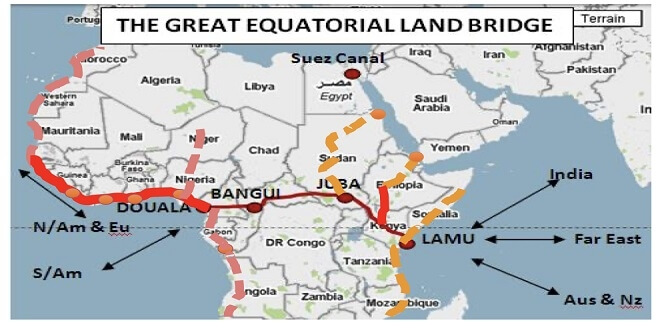
Our Projects are
Transforming African Trade
Quick Contacts
2nd Floor, Fidelity Insurance Centre Waiyaki Way, Westlands

LAPSSET key in Africa’s Integration Agenda
The Lamu Port-South Sudan-Ethiopia-Transport (LAPSSET) Corridor Program and free trade agreements have immensely contributed to the African integration agenda by bringing opportunities closer and reducing regional tensions.
The remark was made by Silvester Kasuku, the Chief Executive Officer (CEO), of the African Center for Transport, Infrastructure and Regional Integration (ACTIRI) and former CEO of LAPSSET Authority, in Nairobi on Tuesday during the sideline of the 7th Program for Infrastructure Development in Africa, (PIDA) Week under the theme
“The investment potentials of the LAPSSET Land Bridge to Central Africa and beyond. The LAPSSET Corridor Program is a regional flagship project intended to provide transport and logistics infrastructure aimed at creating seamless connectivity between the Eastern African Countries of Kenya, Ethiopia and South Sudan.
The project connects a population of 160 million people in the three countries and is part of the larger land bridge that will connect the East African coast from Lamu Port to the West coast of Africa at Douala Port.
According to Kasuku infrastructure projects like the LAPSSET corridor project which is Eastern Africa’s largest and most ambitious infrastructure project is key not only for Kenya, but the whole region as a whole.
He added that the project forges linkages that strengthen East Africa’s regional integration thus creating the new basis needed for economic growth.
While emphasising the project’s unique importance, he said the road has improved connectedness between Kenya, Ethiopia and South Sudan thus generating positive economic synergy between the three countries.
“The project constitutes the greatest land bridge ever planned on the continent, serving as a link to the Belt and Road Initiative and spreading the impact of the 4IR all over Africa,” he said.
He urged that in a bid to make positive strides, Africa needs to transform its population to be a business population that supports growth in Africa. “The private sector is a key partner to governments and RECs in the successful implementation of the LAPSSET,”Kasuku stated.
On his part the Director of the Transportation and Infrastructure Department at the Infrastructure Concession Regulatory Commission (ICRC), Emmanuel Onwodi, said that Developed Economies may not be able to provide the required funding for this project and urged for the exploration of alternative means of funding, including Public Private Partnerships (PPPs), loans from development finance institutions and Tax Credits to corporate institutions. Amb. Francis Kirimi Muthaura, Chair of Kenya Revenue Authority (KRA), said that there is no alternative but to realize LAPSSET’s transformative potential.
“Expediting approvals of mega projects would show that the region is serious about fixing its infrastructure projects thereby attracting a big number of investors,” Amb Muthaura said. Robert Lisinge, Chief of the Energy, Infrastructure and Services Section of the Private Sector Development and Finance Division of ECA emphasize that working together is the key strategy for the success of Africa’s regional infrastructure programmes. “However, collaboration has had limited success recently so far, as shown by the slow pace of implementation of transborder infrastructure programmes,” Lisinge noted.
He highlighted some of the solutions undertaken in Africa’s regional infrastructure such as building political consensus and getting high-level buy-in to move projects forward and taking regional perspectives into consideration when developing national policies.
“This, in turn, could contribute to efforts to reap the full benefits of regional development initiatives, such as the African Continental Free Trade Area (AfCFTA),”Lisinge stated Danilo Desiderio consultant at the United Nations Economic Commission for Africa) noted that investing in infrastructure, alone, is not a guarantee for increasing intra-African trade.
“In fact, soft infrastructure interventions are also necessary to increase border and transport efficiency along trade corridors through a reduction in time, cost and number of documents necessary for import, export and transit operations,” he stressed.
He added that experience of other corridors in Africa has shown that navigating along these corridors can be expensive and frustrating, especially when cross-border transport operations involve the movement of cargo through countries located in the territories of different Regional Economic Communities, due to the need for transport and logistics companies to comply with regulatory frameworks applicable to cross-border transport operations that are deeply fragmented and unharmonized.
Desiderio concluded that considering the plans of the African Union to develop a network of Trans-African Highways to connect the main capitals and centres of production and consumption in the Continent, it will be opportune to overcome the current fragmentation of cross-border road transport regulation and open up a debate on the possibility to develop a regulatory framework at continental level, with the introduction of a pan-African transit guarantee system.
The experience gained so far by each African REC in adopting such schemes, such as the RCTG carnet of the Common Market for Eastern and Southern Africa (COMESA) the Southern African Development Community (SADC) Regional Customs Transit Bond and the new Economic Community of West African States (ECOWAS) community transit guarantee mechanism should in future converge towards a continental solution applicable on all African corridors.
An effective regional transit bond scheme will require to be supported by a platform allowing the electronic exchange of transit messages between all the customs offices involved in transit operations, as well as the implementation of regional cargo tracking solutions able to insure the integrity of cargo during its movement from origin to destination.
In this regard, the Regional Electronic Cargo Tracking System (RECTS) which is already operating on the Northern Corridor should be extended also to South Sudan and hopefully, to the Central African Republic and Cameroon so to ensure a “fast lane” from the Eastern to the Western African coast where cargo in transit can move without interruptions and additional costs for traders.
Read original article
Disclaimer: The views and opinions expressed in this article are those of the authors and do not necessarily reflect the official policy or position of TradeMark Africa.